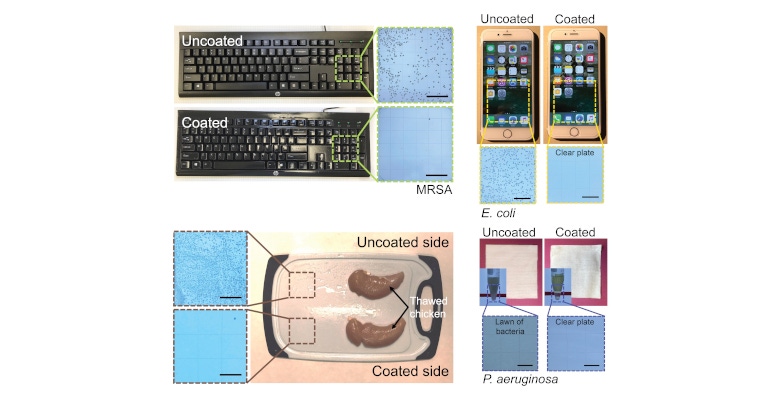Coating for Keyboards and Other Surfaces Shown to Kill COVID-19 and Other Viruses in Minutes
A durable coating for keyboards, cell phone screens, and other surfaces proves deadly to 99.9% of microbes even after months of repeated cleaning, abrasion, and other environmental factors.
September 23, 2022

A team of University of Michigan engineers and immunologists have developed a new durable coating that works by combining antimicrobial molecules derived from tea tree oil and cinnamon oil with polyurethane, a tough, varnish-like sealer commonly used on surfaces such as floors and furniture.
The new coating was evaluated in a study, “Surfaces with instant and persistent antimicrobial efficacy against bacteria and SARS-CoV-2,” published in Matter. The authors explained that currently, surfaces can be disinfected either by using fast-acting, impermanent liquid-, vapor-, or radiation-based techniques, or slower-acting, passive antimicrobial surfaces based on somewhat toxic heavy metals or surface-tethered biocides. This divide between rapid disinfection and long-lived antimicrobial efficacy is an inherent problem in modern day disinfection, the authors stated, given the prompt evaporation from the surface of agents capable of rapid disinfection and the slow dissolution/diffusion of heavy metal ions or tethered biocides.
However, the new antimicrobial coating can rapidly disinfect with a greater than 4-log reduction of current and emerging pathogens within minutes, while maintaining persistent efficacy over several months and under significant environmental duress. The study also found that the coatings can be readily applied onto a variety of desired substrates or devices via simple application techniques such as spray, flow, or brush coating.
“The antimicrobials we tested are classified as ‘generally regarded as safe’ by the FDA, and some have even been approved as food additives,” Anish Tuteja, professor of material science and engineering at U-M and co-corresponding author of the paper published in Matter, explained in an article for Michigan News. “Polyurethane is a safe and very commonly used coating. But we did do toxicity testing just to be sure, and we found that our particular combination of ingredients is even safer than many of today’s antimicrobials.”
The results of the study’s durability tests suggest that the coating could keep killing germs for six months or longer before its oil begins to evaporate and reduce its disinfectant power. But even then, Tuteja said it can be recharged by wiping it with fresh oil; the new oil is reabsorbed by the surface, starting the cycle again.
The developers’ key challenge in creating the coating was to combine the oil and polyurethane in a way that let the oil molecules do their germ-killing work while preventing them from evaporating quickly. A possible solution was found through cross-linking, a process that uses heat to link materials together at the molecular level. The smaller oil molecules were cross-linked to the polymer molecules, but only partially so that some of the oil molecules remained free to be able to penetrate the cell walls of microbes.
“There was some trial and error, but we eventually found that cross-linking only some of the oil did what we needed,” Tuteja said. “The free oil tends to stay with the oil that’s cross-linked into the matrix, helping the coating last longer.”
The team then identified a representative sample of microbes to focus on and developed corresponding solutions to combat them. Tuteja added that the team's understanding of the properties of individual ingredients enables them to tweak the formula for specific applications or rebalance the antimicrobial agents to kill specific germs.
“It’s never our goal just to develop a one-off coating, but instead to develop a library of underlying material properties to draw from,” Tuteja concluded. “If we can understand those properties, then we can develop coatings to meet the needs of specific applications.”
About the Author(s)
You May Also Like



